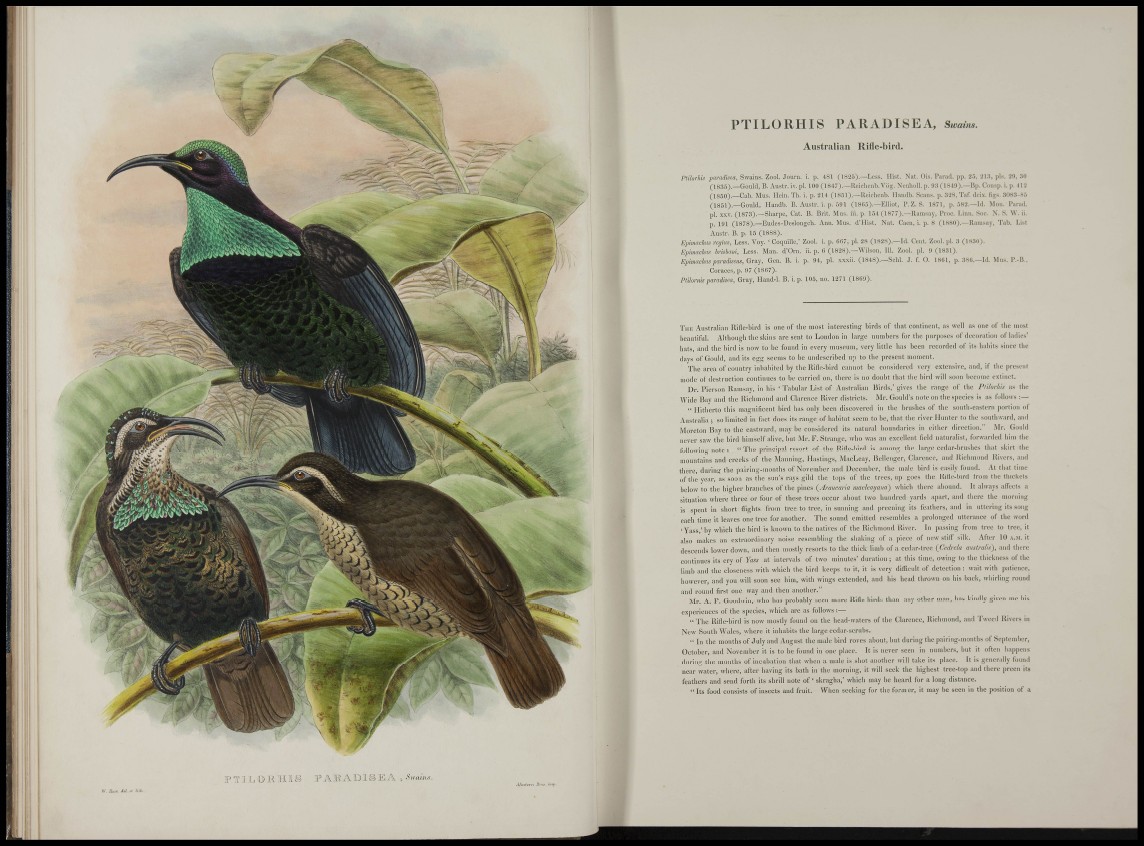
PTILORHIS PARADISEA, Swains.
Australian Rifle-bird.
Plihi-his paradisea, Swaias. Zool. .loiim. i. p. 481 (1825).—Less. Hist. Nat. Ois. Paracl, p]). 25, 2l:i, pis. 20, :10
Q835).—Gould, B. Austr. it. pi. 100 (1847).—Reiclieuli. Vii^'. Ncullull. p. 93 (1849).—Bp- Consp. i. p. 11 •>
("1850).—Cab. Mus. Hcin. Th. i. p. 214 (18S1).—Udi-hcnl). llaiulb. Scans, p. :i28, Taf. tlcix. ligs. :iOH:t-S-|
(1851),_Gould, Handb. B. Austv. i. p. ¡iill (ISliS).-Elliot, P. Z. S. 1871, )>. .')82.—hi. Moii. I'arad.
pi. xxT. (1873).—Sharpe, Cat. B. Brit. Mus. ill. p. 154 (1877).—Ramsay, Proc. UHM. SOC. X. S. W. ii.
p. 191 (1878).—Eudes-Deslongcli. Aim. Mus. d'llist. Nat. Caen, i. ji. 8 (1880).—Uarasay, Tab. I.isl
Austr. B. p. 15 (1888).
Ephmcims ngtm, Less. Voy. ' Coquille,' Zool. i. p. ()fi7, pi. 28 (1828),—Id. Cent. Zool. pi. 3 (18311).
Ephmclms hrisham, Less. Man. d'Orn. ii. p. C (1828).—Wilson, 111. Zool. pi. 9 (18,'il).
EphmcJiUSparadiseus, Gray, Gen. B. i. p. 94, pi. xxxii. (1848).—Schl. ,1. f. O. 1801, p. 3S(i.—Id. Mus. I'.-li,.
Coraces, p. !)7 (1807).
Plllornis paradisea, Gray, Hand-l. B. i. p. 10,5, no. 1271 (1800).
TUB Australian Rifle-bird is one of the most intercstinf; birds of that continent, as well as one of the most
beautiful. Although the skins arc sent to London in largo numbers for tlie purposes of decoration of ladies'
liats, mul the bird is now to be found in every nuiscnm, very little lias been recorded of its habits since the
days ofGouUl, audits egg seems to be uiidescrilied up to the present moment.
The area of country inhabited by the RKle-bird cannot be considered very extensive, and, if the preseni
mode ol destruetioii continues to I)e carried on, there is no doubt that the bird will soon become e.itinct.
Dr. Pierson Ramsay, in his ' Tabular List of Australian Birds,' gives the range of the I'lilorhk as the
Wide Bay and the Richmond and Cliirence River districts. Mr. Gould's note on the species is as follows :—
" Hitherto this magniflcent bird has only been discovered in the lirushes of the south-eastern portion of
Australia ; so limited In fact does Its range of habitat seem to be, that the river Hunter to the sontliivard, ami
Moreton Bay to the eastward, may be considered its natural boundaries In either direction." Mr. Gould
never saw the bird himself alive, but Mr. F. Strange, who was an e.\-cellent field iiatunilisl, fonvarded him the
following note ;—" The principal resort of the Rille-liird Is among the large cedar-brnslics that skirt the
monntains and creeks of the Manning, Hastings, MacLeay, Ikllengcr, (ilarencc, and Richmond Rivers, and
there, during the pairing-months of November and Decemlier, the male bird Is easily found. At that time
of the year, as soon as the sun's rays gild the tops of the trees, up goes the Rllle-bird from the thickels
below to the higher branches of the pines {Araucm-ia mackayann) which there abound. It always aU'ects a
situation where three or four of these trees occur iibont two linudred yards apart, and there the morning
is spent in short flights from tree to tree, In sunning and preening its feathers, and in uttering its soiig
each time it leaves one tree for another. The sound emitted resembles a jirolongcd utterance of the word
' Yass. 'by which the bird is known to the natives of the Richmond River. In passing from tree to tree, it
also makes an extraordinary noise resembling the shaking of a piece of new stilf silk. After 10 .\.m. It
descends lower down, and then mostly resorts to the thick limb of a cedar-tree (Ceclrela wutralis), and there
continues its cry of Yass at intervals of two minutes' duration; at this time, owing to the thickness of the
limb and the closeness with which the bird keeps to it, It is very difficult of detection : wait with patience,
however, aud you will soon see him, with wings e.xtended, and bis head thrown on his back, whirling round
and round first one way and then another."
Mr. A. P. Goodwin, who has probably seen more Rifle-birds than any other man, has kindly given me his
exjieriences of the species, which arc as follows :—
" The Rifle-bird is now mostly found on the head-waters of the Clarence, Richmond, anil Tweed Rivers in
New South Wales, where it inhabits the large cedar-scrubs.
" In the months of July and August the male bird roves about, but during the pairiug-months of September,
October, and November it Is to be found In one place. It is never seen in numbers, hut It often happens
during the mouths of incubation that when a male Is shot another will take its place. It is generally foumi
near water, where, after having Its bath in the morning, it will seek the highest tree-toji and there preen its
feathers and send forth its shrill note of ' skragha,' which may be heard for a long distance.
" I t s food consists of Insects and fruit. When seeking for the former, it may be seen in the position of a
ir, /i(,H .w .n lah .
L O R H I S FABADISKA ,